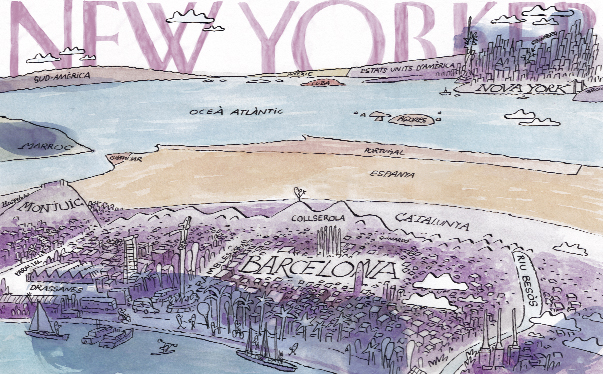The New Yorker weekly magazine is associated with old-style, steady journalism, and long and meticulously documented articles. Barcelona appears in one in twenty of the 4,100 issues published by the magazine since 1925: twice a year on average, although it gets barely ten mentions during Franco’s dictatorship. Some of the most noteworthy articles, when considered together, offer a clear vision of the phases the city has been through, and its relationship with the country, as well as of the sins we have not yet atoned for. And a clear pattern emerges in all the articles: when someone from Barcelona tries to walk with their head held high, New Yorkers look upon them as their peer.
Author Archives: Jordi Graupera
The capital of literary reporting
Magazines produced in New York are a window onto the cosmopolitan world that North-American laws and customs seek to express. Barcelona’s presence in The New Yorker began in 1935, with a description of the Carnival which foreshadows Post-Civil War morality, clashing abruptly with the joie de vivre of the Second Republic, still in power at that time.
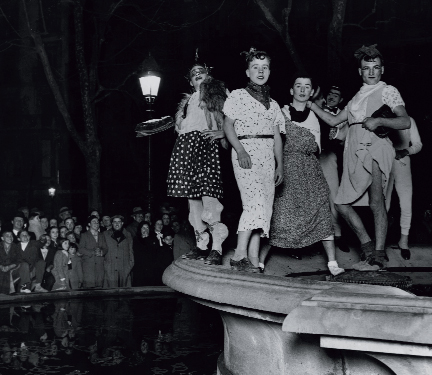
© Pérez de Rozas / AFB
The first references to Barcelona are published in ‘The New Yorker’ in an article about carnival in 1935. The carnival image is from the following year: the burial of the carnival effigy in the Jardinets de Gràcia.
Founded in 1925 with the aim of becoming a satirical and erudite weekly, The New Yorker immediately sold well. It faithfully represents the step-sister-like relationship between the United States’ cultural capital and its hinterland: they love each other through their blood ties. It often seems that they would have to maintain an incestuous relationship, but they keep their distance, one that is born of resentment.
Magazines made in New York are a window onto the cosmopolitan world that North-American laws and customs seek to express, and constitute a powerful incentive for young artists who dream of finding a place on the literary Olympus of the Anglo-American language and of art in general. Journalism is an instrument of power; it explains, with total transparency, the debts that each writer has with their country and the price they pay for the place they hold in the concert of nations. Thus, 20thcentury American magazines are akin to cultural aircraft carriers. Boom-boom, large calibre.
The New Yorker weekly magazine is associated with old-style, deliberate journalism, with long articles. Ten or twenty pages that keep up appearances, written to make language and conversations its own, meticulously documented: always flush with anecdotes and good taste. It is the capital of literary reporting, and it pays well. You look at a powerful city, which leads an upstanding country, and immediately you see its cultural wealth and a breed of creators who have time to write and the room to take risks.
The sadness of a Carnival
If you enter the word “Barcelona” in the search engine of The New Yorker’s archive, you get 223 hits. Since 1925, 4,100 issues of the magazine have been published, which means that Barcelona appears once in every twenty, or twice a year. However, this is the average, since during Franco’s dictatorship there are a meagre ten mentions. The first reference to the city is a brief article from 1935, in the “Talk of the Town” section, namely the cocktail of curiosities that purportedly occupy local chinwags. It is entitled “How Sad”, and reproduces a letter by a citizen of Barcelona who had lived in New York, describing a parade of carnival floats along Passeig de Gràcia. And it ends:
“In the streets hundreds of people dressed almost exclusively as ‘Charlots’ or ‘Gandis’ walk and try to persuade themselves that they’re having a grand time […] Strongly armed mounted police reminded everybody of the drastic prohibitions, as are the ones forbidding the use of masks and throwing any streamers with colours that would offend the morals, the political feelings, and the ‘religious’. I hurried on my way to the American Bar.”
The image is a clairvoyant one: citizens of Barcelona dressed up as Charlie Chaplin’s The Tramp and Gandhi, or in other words as clowns or pacifists (or as anti-fascists or pro-independents, which sounds better), surrounded by armed patrols. Five months have elapsed since 6 October and the outbreak of the Spanish Civil War is a year and a half away. What colour does a streamer have to be to offend political feelings? The reaction of the chronicler, who heads straight for the American Bar, is also premonitory: hedonism as a way out of grief, cocktail cosmopolitanism as asceticism. It foreshadows the post-war morality and clashes with the joie de vivre and mythical agitation of the Republic, still in power.
The other articles focusing on Barcelona are by paid reporters. One in 1944, two from the 1950s and two from the 1960s. After Spain’s transition to democracy, articles multiplied and became both more varied and specific in terms of topics: particularly painting, dancing, architecture, and more recently gastronomy and Woody Allen. There is one from 1992 which, leveraging the Olympic Games, takes a look at Catalan nationalism with some almost microscopic details but which comes up somewhat short as an overview. This, plus the five articles published about Barcelona during the dictatorship, explains the phases the city has been through, and its relationship with the country, as well as the sins we have yet to atone for.
Far away, very far away from Madrid
The article by Marya Mannes, published in 1944, is a war article. The Allies had landed in Normandy six months previously and Paris was liberated in August. The implicit question is whether crossing the Pyrenees with the Allied army is an advisable undertaking.
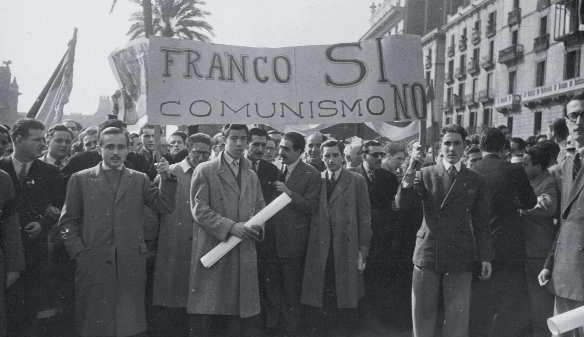
© Pérez de Rozas / AFB
Demonstration in support of Franco on the Passeig Marítim, on 21 February 1946. The writer and critic Marya Mannes viewed Barcelona as a potential ally given the existence of a nation oppressed by the Spanish fascists.
The article’s topic, published in the form of a “Letter from Barcelona”, was newsworthy: at home I keep a cover of Time, also from 1944, with a map showing the Iberian Peninsula with Franco’s face superimposed, and which reads: “Franco of Iberia. An advance against him is an advance against Hitler.”
Mannes lists the virtues and the defects of the Catalans with regard to American interests. The article reeks of a Department of State report taken to the extreme: “Catalans of all groups will be in the first wave of revolt,” it concludes. And then the but kicks in: we do not know if they are serious enough. The opening paragraph makes it quite clear that Barcelona is Catalonia and Madrid is Franco, after which the article explores this dichotomy further:
“Barcelona is a long, long way from Madrid. Barcelona is Catalan and Madrid is Castilian, and the mountains that separate Catalonia from France are not as high as the invisible barrier between Catalonia and Castile. Madrid is the past and Barcelona the future of a once great nation. Like all seaports, Barcelona is a natural city, which has grown out of its geography. Madrid is an artificial city, an arbitrary capital.”
The reason why Barcelona may be an ally is the existence of an underlying nation, a nation oppressed by the Spanish fascists – the golden years of the Falangists. Any reader who had followed the World War in the American press would be conversant with this topic. The Catalans, like the French or Austrians, make for a transparent map of alliances and an inevitable conclusion.
Mannes’s Barcelona resembles Manhattan: it is portrayed as a city with contemporary art museums, numerous bookshops and well-educated and liberal people. The mysticism of Montserrat and the Mediterranean lightness of spirit “make a fine creative mould”. The Liceu hobnobs with La Scala and the Paris Opera, and the Russian ballet is a frequent visitor; Pau Casals, “the world’s greatest cellist”, is Catalan; and there is even a Japanese orchestra conductor who is a regular at the Ritz bar, where he peruses the Daily Mail. The Catalans, she says, read a lot, and since almost everything is censored, the in book is a biography of Churchill and a Mickey Mouse comic: they are just like us! Industrialists are pro-American, and everyone works harder and is more receptive to change and progress, not like in Madrid, where they live by their wits and are close minded. She mentions Destino magazine, “which has somehow managed to be pro-Ally” despite Franco, and La Cordoniz (“a completely non-political weekly that devotes itself to gags, jokes, satires, and expert cartoons”), the sole exceptions to a discursive, emotional journalism, totally dedicated to government propaganda. And even “the Barcelona girls […] walk with freedom and assurance, almost like American girls”. And she concludes: “Barcelona has, in general, an American spirit; its energy, eagerness, curiosity and humour provide a contrast to the dark, ingrowing nationalism of central Spain.”
The article goes on to focus on the injustice suffered by the city, and Catalonia with it. It voices the claim to Catalan nationalism taking precedence over Communist or Anarchist claims, and this suggests that it wants the general public to be in favour of an Allied intervention in Spain, just like Time. However, it also raises a more profound issue: the future of Barcelona is Catalonia, and the city’s power hinges on culture in its broadest sense, on its history and on its ambition, rather than on ideology.
Chaos, defeat and humiliation
The articles of the Fifties depict a defeated and vulgar country, whose only saving grace is its Mediterranean exoticism. They crystallise the myth of the Barcelona good life, driven by disorder, heat, the bohemian lifestyle, unpunctuality, sex and, in general, a laid-back, dirty and cultureless carpe diem. There is an underlying sadness, silence.
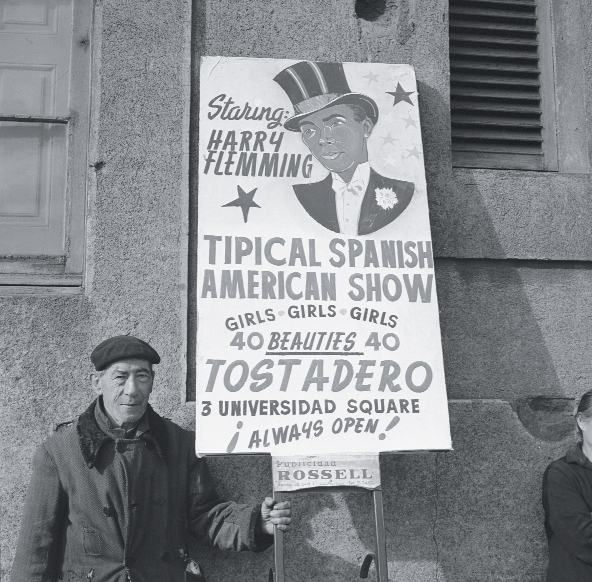
© Nat Farbman / Time & Life Pictures / Getty Images
Articles from the Fifties reveal a defeated and down-at-heel country. In the photo, a billboard advertising a “Tipical Spanish American Show” intended for sailors of the US Sixth Fleet, in January 1952.
The 1955 article is penned by Joseph Wechsberg, writer, journalist and Czech musician, and a well-known anti-Nazi fighter as of the 1930s. Parliamentary secretary of the Czech Jewish Party and defender of the Sudetenland cause in the United States, Wechsberg adopted US citizenship at the beginning of the Second World War and returned to Europe with the North American troops in 1943 as a war correspondent. After the conflict he worked for the War Crimes Commission and wrote The Murderers Among Us (1967), in which he unmasked former Nazi officers hiding out in Latin America or conveniently suffering from memory loss in Berlin. Hardly light reading.
However, Wechsberg’s article has little to do with Mannes’s. It is not political, and not even cultural in the broadest sense. It is a very entertaining caricature of a Viennese opera company that is premiering a Mozart and a Wagner in the Liceu. The difference between the definitions of Barcelona by Mannes and Wechsberg are worth mentioning, as the latter writes: “Barcelona is not only the second-biggest city in Spain but the noisiest; the noisiest part of Barcelona is the old Gothic Quarter, which is cut through by the Rambla, the city’s most picturesque thoroughfare.”
The rest of the long article is an elaboration on this theme. If Mannes read it she would have concluded that the “levelling” process orchestrated by the regime – which she mentions in her 1944 article – had reached its objectives very successfully. The erudite and modern city, which had tapped into the spiritual and material progress of the west, has become a den of corruption and slovenliness; the hotel room is like a monk’s cell, and the conversations and partying into the wee small hours lilting in from the Rambla preclude any possibility of some shut-eye for the prima donnas and the directors lodged at the Hotel Oriente.
The citizens of Barcelona are soccer-crazy and bullfight-crazy; apparently they are opera-crazy, and although many do not actually frequent the Liceu they do talk about the highlights. The singers, so used to Vienna, are homesick – the baritone is fed up of fish three times a day – and they catch colds from so much nightlife and so little rest. They complain incessantly: what an uncivilised country! The city lives by night: the shops close after midnight and do not open till noon the next day; performances begin at ten in the evening, even though the venue is still empty, although people trickle in; the intermissions are longer to give people time to hold long conversations and so that the women can show off their colourful dresses; and the technicians and extras, once the performance is over, after two in the morning, go out drinking until six. The firemen smoke on duty near the props. “They’re always cooperative, and never irritable. Must be the fresh fish they eat,” said the company director. Nobody would ever say that a mere 11 years had elapsed since the last article.
The picture painted must have struck The New Yorker readers as exotic, and Wechsberg was probably exaggerating on purpose, but the take-home message was that that there was no country or basic standards. Under the scab of the regime, however, there nestled a force pushing out towards hedonism. There was no fighting spirit, but rather a good, lively, 19th century-style, popular and oily bohemian spirit.
Indeed, back in Vienna, after a resounding and exquisitely Nordic success, the singers that had complained so much were already missing the warmth of the people of Barcelona and the sauciness of its girls. This is the Spanish Barcelona and African Spain. Sun, sex and wine. The Pyrenees are a border. The fact that a Sudeten Jew, a historic combatant, comes to Barcelona and this is the sum total of what he sees is illustrative of the city’s state of utter decomposition, but also of a change in the interests of the readers and the North-American powers that be. The article is flanked by ads for swimwear for ladies and whiskey for gents. At that time, the priciest ticket for the Liceu Opera house was eight times the cost of an issue of The New Yorker; the American government already had four military bases in the Iberian Peninsula; Spain is in the process of internationalisation – UNESCO, the UN, a preferential agreement with the EEC – thanks to the Cold War, and we are four years away from the intervention of the IMF and on the verge of the government of the Opus technocrats. Country and city have hit rock bottom, and there is no sign of a recovery.
The article from 1956 paints a similar picture. It is a strange piece by Frederick L. Keefe, a Hollywood screenplay writer, about a car journey from Madrid to Barcelona. There is no documentation, political or ideological intent. It is all description. Keefe is in a car and when they reach Medinaceli he picks up a rather impoverished-looking Cambridge-educated Catalan historian. After criticising the stupidity of Franco’s dictatorship throughout the journey, the historian cheers Franco’s retinue before a group of Civil Guards in a scene reminiscent of Welcome Mister Marshall. In a description that inspires veritable pathos, Keefe explains how the historian was withdrawn and uncomfortable for the rest of the trip. Finally, when Keefe, very politely, asks him what’s the matter, the historian apologises for his lack of consistency. Feeling inferior to the American, his sole justification is an utterance that must have been humiliating for the Cambridge graduate: “In Spain you often have to think one way and act another. Do you know what I mean?” The picture of the 1950s is now complete: collective chaos, cultural defeat and intellectual humiliation: provincials, cowards and survivors.
Recovery and mental acquiescence
The two articles from 1961 and 1963, on the other hand, prove that Catalonia has resurfaced. They are by Alastair Reid, an American writer of Scottish origin. As in 1944, they constitute an extremely well-documented compendium of cultural and political clichés of Catalan nationalism; and clearly show that Barcelona depends on the strength of Catalonia, and vice versa. The more Catalan Barcelona is, the further it explores the possibilities of its history, the more cosmopolitan, the more modern, the more European it is; and the more understandable for the reader.
The article from 1961, also entitled “Letter from Barcelona”, is 40 pages long and is the main story. Reid says that Barcelona had two different histories: a long and honourable one that commences with its foundation, a commercial and strategic seaport since Roman times, the capital of one of the Mediterranean’s grand nations, independent of spirit, industrious and valiant; and the other, a short and brutal history that begins with industrialisation. He uses these historic foundations to describe the reality of the 1960s, economically depressed and culturally “hampered”. However, there is something astir; there is a fresh lease of life, and the country becomes visible.
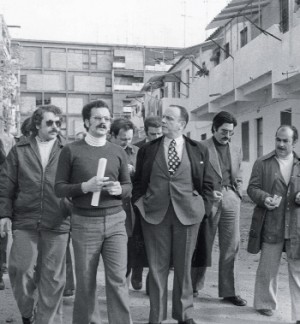
© Pérez de Rozas / AFB
Manuel Fraga Iribarne during a visit to social housing neighbourhoods in January 1975, shortly before he was appointed as Minister of Governance and the Deputy Prime Minister of the first post-Franco Transition Government.
The Spain of the 60s was the result of the economic growth triggered by growth in Europe, North-American aid and the Stabilisation Plan of 1959. Whereas the article from 1961 depicted an impoverished, albeit still alive, country, reeling from the reforms of 1959, the 1963 article shows that the reforms had worked. This led to a kind of mental acquiescence which accepted the historic strength of Francoism and the marketing of the myth of the “Spanish Miracle”. Fraga was the publicist orchestrating the aperture of the regime and was the most likely candidate to succeed the old dictator. On the other side of the scales is a precise description of the mental condition of those who survived the war, plagued by nightmares, anguish and silence.
However, of all the explanations proffered by Reid, Catalan nationalism is the last hope. Reid looks upon us with friendliness, and laments the failure of the Catalan state (“a tragedy within a tragedy”), but at the same time he makes it clear that the movement is politically defunct. At the beginning of the century, he says, separatism had all the makings of a real movement: own culture, modern economy and political ideas, but now it is merely a corpse that nobody deigns to claim, forgotten in a fridge in the morgue. As he considers that the country is actually capable of amounting to something, he senses that the fact that it has amounted to nothing should be put down to anthropology. He constructs a discourse on the Barcelona way of life which will be definitive: the good life in the south means that Spaniards know next to nothing about the most elementary political responsibility. And Catalans are incarcerated between the regime of a short military sadist with a repulsive woman’s voice and the mental limitations of their sensuality, which explains the total lack of discipline, outbursts that lead nowhere, economic pragmatism and an innate penchant for freezing the present, eternally suspended in the sun and inner joy, rather than for speed and the cost of the future. The price of moral anarchism is this downtrodden life, this permanent defeat, which need only be borne by a metaphysical predisposal.
This does not mean that it is devoid of all optimism, since there is a faintly beating heart in there. He finds Barcelona disarming because he sees it as modern and up for anything, erudite, with substance, but neither the elites nor the people have the muscle power or the willpower to take this rhetorical desire to the next level. He uses the word “hampered” twice. There is enough material in the article for a PhD thesis, and it demonstrates that psychology and a centuries-long historical context are needed to understand Catalonia and Barcelona and to explain them both.
1992 and the postmodern quagmire
On the occasion of the Olympic Games, the magazine published another leading article about Catalonia. Barcelona is portrayed as rooted in consumerism, a paradigm of the late-capitalist welfare society. The law of resetting memory yields its fruits, but ends up being confused with reality.
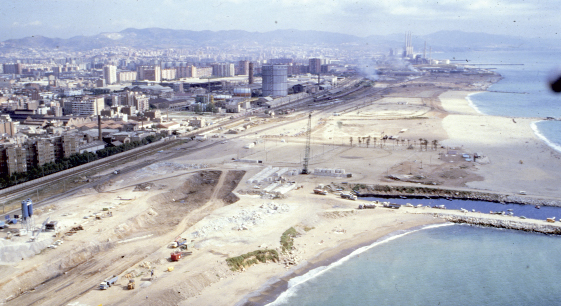
© AFB
Aerial view of the coastline during construction of the Olympic Village, in an image taken in September 1987.
After the transition, articles and topics multiply until 1992, when, with the Olympics as the backdrop, the magazine published a main spread, this time entitled “Catalonia”, penned by William Finnegan, one of its best-known journalists. It is a prodigy of English-language journalism by dint of its detail, professionalism and spot-on diagnosis. Barcelona is a postmodern quagmire, anchored in consumerism, the paradigm of the late-capitalist welfare society. Ideologies have been watered down by large-format TV screens and the service economy. Catalan nationalism appears as a bourgeois and conservative undercurrent which has taken the soft form of Maragall’s “socialist cosmopolitanism”; of Maragall he says he is a man that feels comfortable with the impure juggling act of contemporary politics.
Catalans, and particularly people from Barcelona, feel their skin tingle when they think about 1992. After the Games, the citizens of Barcelona shamelessly flaunted their new-found pride the world over. Seeing the reaction of foreigners when you say you are from Barcelona shows that we have good reason to be proud, but, at the same time, people from Barcelona can also come across as self-infatuated show-offs. We exaggerate our self-love because it is the only love we have. And we look upon clients as lovers. My sister was given a lesson on this when she lived in London. A Dutchman asked her where she was from, and she replied “from the best city in the world”. “From Barcelona,” said the Dutchman. “Yes, how did you know?” asked my sister. “Only someone from Barcelona would say something like that,” replied the other.
Historically, the Games were a turning point. The city offloaded some obvious shortcomings and started to build. The 1960s were thawed. The world fell in love with the city with the greed of termite tourists. The article from 1992 is good precisely because it manages to see beyond the bricks and mortar aspect, and describes, with surgical precision, the psychological condition of a country that has decided to focus on a service-based industry, making the most of its geography. Reid’s warning in his article from 1961 about the tendency to live off sun and sand met with the perfect reply in Finnegan’s article from 1992. In 1963 Reid quoted a Spanish economist who, when asked about the tourist industry, referred directly to the prostitution of the country. And a mechanic told him: “A few years ago I was ready to burn down my grandmother,” but now “I’d rather work”. In perfect continuity, in the 1992 article Finnegan explains the ideological evolution of a mayor from a town near Barcelona, Castelldefels, erstwhile communist and representative of the working class immigrants, who made the most of the building of the Olympic canal to reinvent the town as a centre for hedonists. His voters, he says, are no longer workers; they are technicians.
Amnesia as a cultural paradigm
The generation that did things in 1992, educated in the late Francoist period, imposed the cultural paradigm of amnesia and kept traumatism at bay with anxiolytics. It is a psychotropic zenith, and everyone congratulated themselves on the success. Finnegan interviews Rubert de Ventós, who warns of the global danger of nationalism, and quotes Aristotle by saying “whoever wants to organize a polis must organize the amnesia of the people”. However, there is also a local journalist hailing from Castelldefels who says he feels lonely because he is the only Catalan speaker in a Spanish-speaking city.
The image conveyed by the article combines the economic success that has turned the Spanish immigrant workers of the dictatorship into a large middle class typical of western democracies, with the dissection of the cultural gash engendered by the presence and number of these “people from Andalusia, Murcia and Extremadura”. Nevertheless, broadly speaking, alchemy has kept Catalan nationalism at the centre of politics, which is a mutual protection system shored up by equilibrium, not by justice or dignity. It is security, not freedom. The example is a businessman wandering around at a reception in the Pedralbes Palace – “where Franco had stayed when he came to Barcelona” – where it is clear that the Catalan elite is but a small clique and everybody knows everybody else. Pujol and Maragall have laid their differences to rest, and Samaranch presides over happiness and consensus. The businessman in question wanders around amid canapés and laughter. He made his fortune by flogging apartments with aluminosis to immigrants in the 1960s and is now one of the major patrons of Barcelona’s new Museum of Contemporary Art. Hey, everyone lands on their feet. The Castilian elites are no longer in the limelight, but they are still a fine and all-pervading veneer, and the Catalan bourgeoisie, thitherto industrial, now turns to toast the economic success of a Barcelona powered by tourism and real estate.
A few people make a real killing and in general everyone gets a slice of some size. Moreover, the chance to be in the crosshairs of the world’s main TV channels spurs on all forces, dead or alive, to tout their truth somewhere or other, albeit without altering the moderate and complacent tone. Even the official critics, such as Vázquez Montalbán, take advantage of the situation by publishing articles, police novels set in this new and memory-challenged Barcelona. And he tunes into TV channels from all over the world from his house in Collserola. He is the spokesperson of the local intelligentsia. With a tinge of irony, Finnegan describes Montalbán as a “democratic communist” and gourmand.
It was at the time of the war in Bosnia and the contrasts between Sarajevo and Barcelona are the focal point of all analyses and emotion. Also in the article, as was only to be expected, are adolescents dishing out leaflets about Freedom for Catalonia, but it is hard to believe that this ostensibly comfortable society is a victim of oppression. Absolute calm amid gesticulations and wads of banknotes. The law of resetting memory yields its fruits, but ends up being confused with reality: as if city and country had really started from scratch 20 years earlier. And the city had appeared by spontaneous generation.
City and country had been burdened by the consequences of this emptiness until it imploded in the present, 20 years later. The city was reborn and destroyed at the same time. The naivety and bonhomie of Friends for Life leaves us alone and disarmed; the image and summary of the 2004 Forum of Cultures. The emergence of splendour and glory of Codswallop International.1
Samaranch is a case in himself, and the article gives him generous coverage. Finnegan asked every interviewee – politicians, teachers, journalists, ordinary citizens – about Samaranch and his Fascist past. The emerging portrait is spikier than the recently penned doubt-laden obituaries. He was more of a Falangist than was necessary; he annihilated his Catalan roots; he devoted himself to sport, the main instrument of regimentation of authoritarianism; he always landed on his feet; he reached the summit of the IOC thanks to support from the hardly or totally undemocratic elites of the former USSR whom he met as ambassador in Moscow; he clung to the position in a decidedly un-gentlemanly style and was the brains behind Barcelona being chosen to host the Games. The King made him a marquis and the Olympic Barcelona suits him and his followers. And his past is forgiven because the prevailing paradigm is amnesia and because, if you choose prostitution, then you might as well make sure that you get yourself a pimp who dolls you up and gets you good clients instead of having to ply your wares on the street on your own. Clearly he is an enemy of the values of The New Yorker’s readers. And Finnegan tries to understand how a country can forgive a Fascist past to the point of glorification.
Catalan nationalism and banality
Catalan nationalism appears as a disconcerted force run through the filter of postmodern banality. The article echoes the criticism by the Convergence and Union party’s opposition to the PSC (Socialists’ Party of Catalonia) mayor of Castelldefels, and ridicules it for being disproportionately historicist and demagogic. Nobility is nowhere to be seen, but we do have the pax of abundance. If a major crisis ever occurs, says Finnegan, tribalism or the most consistent and violent nationalism could emerge. Nowadays, not even the Olympic Games can prove that homelands are still relevant: forget eastern and western blocs and flags; brands are calling the tune now. Michael Jordan refuses to wear Reebok because he’s with Nike; and Cuban baseball players dream of big-bucks contracts in the US league.
Overall, Barcelona is consolidated as a fine host, moderately bohemian, happy, beautiful. Everyone is so comfortable that there is no need to believe in anything too seriously. The only malcontents are those who never got their hand in the till, actually a minority. The fact that there is no historic reference links the article to those of the 1950s, and it is also symptomatic of the disinterest of the reader and the natives. And Finnegan’s, for that matter. The article is the perfect context for other, post-transition scenarios: gastronomy, art, travel and little else.
So we therefore have the Allied Barcelona of the 1940s, the African Barcelona of the 1950s, the Barcelona of the “Catalan myth” and “Spanish Miracle” of the 1960s and the tourist Barcelona of the 1990s. The articles penned in the wake of the transition to democracy elaborate on the cultural aspect: particularly Picasso, Dalí and Gaudí, but also Savall, Bolaño, Ferran Adrià and Portabella. Barcelona appears as the redoubt of a major plastic arts tradition, but also as a top-notch tourist destination. In the 1980s, the reviews are steadfastly highly favourable, but as the 1990s progress, and particularly into the first decade of this century, the enthusiasm is tinged with nuances. The extreme is the review of an exhibition from 2007 in The New York Metropolitan Museum, entitled “Barcelona and Modernity: Gaudí to Dalí”. The author, after saying that the works of Picasso, Dalí and Gaudí make him want to get on the line to a travel agency, ends up oversaturated. The pointlessly abundant Picassos and the banging of own drums may suggest that Barcelona is all facade, a smug city. Picasso, Dalí and Gaudí are geniuses, he says, but when all is said and done everyone has to come from somewhere. The place matters little.
Any foreign look at a city is flawed by the interests it defends. The New Yorker, while it is left-wing and at some point has harboured counter-cultural aspirations, is a self-righteous archetype which engages in both humour and criticism, but never self-destruction. A city, in the eyes of The New Yorker readers, has to be a political subject – such as London or Pari s– or else be an object for consumption – such as Bali. The more political a city strives to be, the greater the respect afforded to it as an object of consumption; and the more insignificant its ambitions are, the greater the likelihood of it being set upon by pirates. Thus, the only pattern that runs clearly through all the articles is: in each setting, when someone from Barcelona tries to walk with their head held high, New Yorkers look upon them as their peer.
Editorial note
1. Reference to the name of Quim Monzó’s book of collected articles (Quaderns Crema; Barcelona, 2010): Esplendor i glòria de la Internacional Papanates [Splendour and Glory of Codswallop International].



